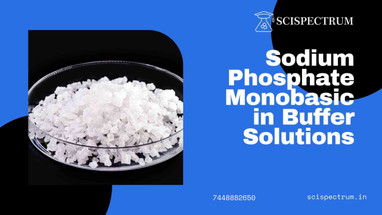Posted by Scispectrum on 22nd Aug 2025
Sodium Phosphate Monobasic: A Key Player in Maintaining pH Stability in Buffer Solutions
In the delicate dance of biological and chemical processes, maintaining a stable pH is crucial. Even slight fluctuations can disrupt reactions, denature proteins, or alter cellular functions. This is where buffer solutions come into play, acting as pH guardians, resisting changes that could derail experiments or industrial processes. Among the many buffering agents available, Sodium Phosphate Monobasic (NaH2PO4) stands out as a versatile and reliable component, contributing significantly to pH stability in a variety of applications.
Understanding Sodium Phosphate Monobasic: A Chemical Profile
Sodium Phosphate Monobasic, also known as Monosodium Phosphate or Sodium Dihydrogen Phosphate, is a white crystalline powder readily soluble in water. Its ability to act as a buffering agent stems from its amphoteric nature, meaning it can act as both an acid and a base. This dual nature allows it to either donate or accept protons (H+), effectively resisting changes in pH within a specific range.
Why Sodium Phosphate Monobasic is a Preferred Choice for Buffer Solutions
Several advantages make Sodium Phosphate Monobasic a popular choice for buffer preparation:
1. Biocompatibility: Sodium Phosphate Monobasic is generally compatible with biological systems, exhibiting minimal interference with most biological processes. This makes it suitable for applications involving cells, enzymes, and other biomolecules.
2. Wide Buffering Range: Sodium Phosphate Monobasic, when combined with its conjugate base, Sodium Phosphate Dibasic (Na2HPO4), creates a buffer system effective across a wide pH range, typically from 5.8 to 8.0. This versatility makes it suitable for a broad spectrum of applications in research and industry.
3. Ease of Use: Sodium Phosphate Monobasic is readily available and easy to handle. It dissolves easily in water, and the pH of the buffer can be adjusted by varying the ratio of monobasic to dibasic forms.
4. Cost-Effectiveness: Sodium Phosphate Monobasic is relatively inexpensive compared to other buffering agents, making it an economical choice for routine laboratory work and large-scale industrial processes.
Applications of Sodium Phosphate Monobasic Buffers
The versatility of Sodium Phosphate Monobasic buffers leads to diverse applications:
1. Molecular Biology: Sodium Phosphate Monobasic buffers are commonly used in DNA and RNA isolation, polymerase chain reaction (PCR), and various enzymatic reactions. They provide a stable pH environment for these sensitive processes, ensuring optimal results.
2. Protein Biochemistry: Sodium Phosphate Monobasic buffers are essential for protein purification, crystallization, and enzymatic assays. They maintain the structural integrity and activity of proteins, enabling accurate analysis and characterization.
3. Cell Culture: Sodium Phosphate Monobasic buffers are used in cell culture media to maintain the physiological pH required for cell growth and viability. They provide a stable environment for cells to thrive, supporting their metabolic processes.
4. Pharmaceutical Industry: Sodium Phosphate Monobasic buffers are used in the formulation of various pharmaceutical products, ensuring the stability and efficacy of drugs.
5. Food Industry: Sodium Phosphate Monobasic is used as a food additive, acting as a buffering agent, emulsifier, and acidity regulator in various food products.
Considerations When Using Sodium Phosphate Monobasic Buffers
While Sodium Phosphate Monobasic offers numerous advantages, certain considerations are crucial for its effective use:
1. Temperature Sensitivity: The pH of Sodium Phosphate Monobasic buffers is temperature-dependent. As temperature increases, the pH of the buffer decreases. This effect should be considered when designing experiments, especially those involving temperature changes.
2. Precipitation with Calcium and Magnesium: Sodium Phosphate Monobasic can form precipitates with calcium and magnesium ions, potentially interfering with certain reactions or processes.
3. Microbial Growth: Sodium Phosphate Monobasic can support microbial growth, so appropriate sterilization techniques are necessary for applications involving cell culture or other sensitive systems.
Choosing the Right Concentration and pH for Your Buffer
The appropriate concentration of Sodium Phosphate Monobasic for a buffer depends on the desired pH and the buffering capacity needed for the specific application. Typically, concentrations range from 10 mM to 100 mM. The pH can be adjusted by varying the ratio of monobasic to dibasic forms, using a pH meter for accurate measurement.
Preparing a Sodium Phosphate Monobasic Buffer
Preparing a Sodium Phosphate Monobasic buffer involves dissolving the appropriate amounts of monobasic and dibasic forms in water and adjusting the pH to the desired value using a strong acid or base. The solution is then made up to the final volume with water.
Conclusion: A Reliable Partner in pH Control
Sodium Phosphate Monobasic stands as a testament to the importance of pH control in a wide range of scientific, industrial, and everyday applications. Its versatility, biocompatibility, and ease of use make it an indispensable tool for maintaining a stable pH environment, ensuring the success and reliability of experiments, processes, and products. By understanding its properties, applications, and considerations, researchers and industry professionals can effectively utilize Sodium Phosphate Monobasic to achieve their desired pH goals.

